词汇学复习重点
英语专业词汇学重点
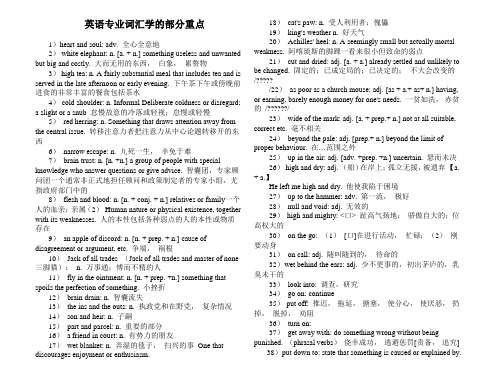
英语专业词汇学的部分重点1)heart and soul: adv. 全心全意地2)white elephant: n. [a. + n.] something useless and unwanted but big and costly. 大而无用的东西,白象,累赘物3)high tea: n. A fairly substantial meal that includes tea and is served in the late afternoon or early evening. 下午茶下午或傍晚前进食的非常丰富的餐食包括茶水4)cold shoulder: n. Informal Deliberate coldness or disregard;a slight or a snub 怠慢故意的冷落或轻视;怠慢或轻慢5)red herring: n. Something that draws attention away from the central issue. 转移注意力者把注意力从中心论题转移开的东西6)narrow escape: n. 九死一生,幸免于难7)brain trust: n. [n. +n.] a group of people with special knowledge who answer questions or give advice. 智囊团,专家顾问团一个通常非正式地担任顾问和政策制定者的专家小组,尤指政府部门中的8)flesh and blood: n. [n. + conj. + n.] relatives or family一个人的血亲;亲属(2)Human nature or physical existence, together with its weaknesses. 人的本性包括各种弱点的人的本性或物质存在9)an apple of discord: n. [n. + prep. + n.] cause of disagreement or argument, etc. 争端,祸根10)Jack of all trades (Jack of all trades and master of none 三脚猫):n. 万事通;博而不精的人11)fly in the ointment: n. [n. + prep. +n.] something that spoils the perfection of something. 小挫折12)brain drain: n. 智囊流失13)the ins and the outs: n. 执政党和在野党,复杂情况14)son and heir: n. 子嗣15)part and parcel: n. 重要的部分16)a friend in court: n. 有势力的朋友17)wet blanket: n. 弄湿的毯子,扫兴的事One that discourages enjoyment or enthusiasm.18)cat's paw: n. 受人利用者;傀儡19)king's weather n. 好天气20)Achilles' heel: n. A seemingly small but actually mortal weakness. 阿喀琉斯的脚踝一看来很小但致命的弱点21)cut and dried: adj. [a. + a.] already settled and unlikely to be changed. 固定的;已成定局的;已决定的;不大会改变的/?????/22)as poor as a church mouse: adj. [as + a.+ as+ n.] having, or earning, barely enough money for one's needs. 一贫如洗,赤贫的/??????/23)wide of the mark: adj. [a. + prep.+ n.] not at all suitable, correct etc. 毫不相关24)beyond the pale: adj. [prep.+ n.] beyond the limit of proper behaviour. 在…范围之外25)up in the air: adj. [adv. +prep. +n.] uncertain. 悬而未决26)high and dry: adj. (船)在岸上;孤立无援,被遗弃【a. + a.】He left me high and dry. 他使我陷于困境27)up to the hammer: adv. 第一流,极好28)null and void: adj. 无效的29)high and mighty: <口> 趾高气扬地;骄傲自大的;位高权大的30)on the go: (1)[口]在进行活动,忙碌;(2)刚要动身31)on call: adj. 随叫随到的,待命的32)wet behind the ears: adj. 少不更事的,初出茅庐的,乳臭未干的33)look into: 调查,研究34)go on: continue35)put off: 推迟,拖延,搪塞,使分心,使厌恶,扔掉,脱掉,劝阻36)turn on:37)get away with: do something wrong without being punished. (phrasal verbs)侥幸成功,逃避惩罚[责备,追究] 38)put down to: state that something is caused or explained by.(phrasal verbs)把……归结于39)follow one's nose: [v. + poss. + n. ] go straight ahead, go in the same direction. 笔直走,凭本能做事(verb phrases)40)make it: [v.+ pron.] arrive in time; succeed. 及时赶到,成功(verb phrases)41)fall flat: [v. + a.] fail completely in its intended or expected effect. 达不到预期效果,完全失败(verb phrases)42)give sb. the bag: [v. + pron. + n. ] fire or dismiss somebody. (verb phrases)43)sing a different tune: [v. + a. + n.] change one's opinion or attitude (verb phrases)44)call it a day: [v. + pron. + n.] decide or agree to stop either temporarily or for good. 暂时停止;结束一天的工作(verb phrases)45)chop and change: [v. + conj. + v.] fluctuate or vary constantly; keep changing one's opinion, etc. 持续浮动或变动;不断变换注意和观点,等等(verb phrases)46)swim against the stream: [v. + prep. phrase] do the opposite of what most people want to do; go against the way things are happening. 反潮流;逆潮流行事(verb phrases)47)come back to earth: [v. + adv. + prep. phrase] stop imagining or dreaming. (verb phrases)48)make ends meet: [v+n+v] earn what it costs to live. 收支相抵(verb phrases)49)keep the pot boiling: [v+n+v-ing] earn enough to maintain an adequate standard of living; keep a situation active, amusing, etc. 谋生,维持生活,使保持活泼(verb phrases)第一章1. Word --- A word is a minimal free form of a language that has a given sound and meaning and syntactic function.2. There is no logical relationship between sound and meaning as the symbolic connection between them is arbitrary and conventional. E.g. "woman" means 'Frau' in German, 'Femme' in French and 'Funv 'in Chinese. On the other hand, the same sound/rait/ can mean right, rite and write, though denoting different things, yet have the same sound.3. The difference between sound and form result from 4 major factors.(At least 80%of the English words fit consistent spelling patterns)a)。
英语词汇学复习大纲整理
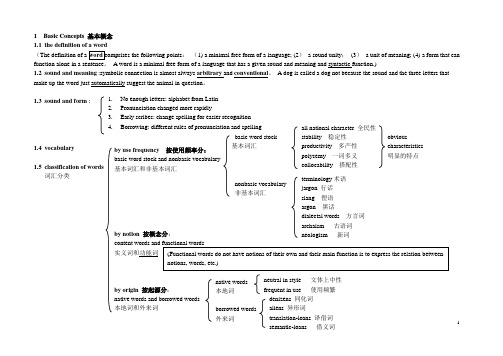
1 B a s i c C o n c e p t s 基本概念1.1 the definition of a word(: (1) a minimal free form of a language; (2) a sound unity ; (3) a unit of meaning; (4) a form that can function alone in a sentence 。
A word is a minimal free form of a language that has a given sound and meaning and syntactic function.)1.2 sound and meaning :symbolic connection is almost always arbitrary and conventional 。
A dog is called a dog not because the sound and the three letters thatmake up the word just automatically suggest the animal in question 。
1.3 sound and form : 1.4 vocabulary 1.5 classification of words 词汇分类 basic word stock 基本词汇nonbasic vocabulary 非基本词汇 by use frequency 按使用频率分: basic word stock and nonbasic vocabulary 基本词汇和非基本词汇by notion 按概念分:content words and functional words实义词和功能词by origin 按起源分: native words and borrowed words 本地词和外来词 all national character 全民性stability 稳定性 productivity 多产性 polysemy 一词多义 collocability 搭配性terminology 术语jargon 行话slang 俚语argon 黑话dialectal words 方言词archaism 古语词neologism 新词neutral in style 文体上中性frequent in use 使用频繁native words 本地词 borrowed words 外来词 denizens 同化词aliens 异形词translation-loans 译借词1. No enough letters: alphabet from Latin2. Pronunciation changed more rapidly3. Early scribes: change spelling for easier recognition4. Borrowing: different rules of pronunciation and spelling obviouscharacteristics明显的特点(Functional words do not have notions of their own and their main function is to express the relation betweennotions, words, etc.)2 D e v e l o p m e n tIt is assumed that the world has approximately 3, 000 (some put it 5, 000 ) languages , which can be grouped into roughly 300 language families on the basis of similarities in their basic word stock and grammar. 2。
英语词汇学知识点整理
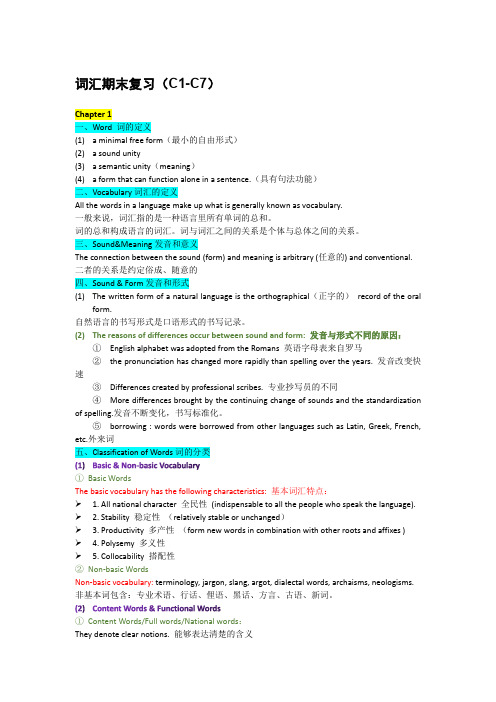
词汇期末复习(C1-C7)Chapter 1一、Word 词的定义(1) a minimal free form(最小的自由形式)(2) a sound unity(3) a semantic unity(meaning)(4) a form that can function alone in a sentence.(具有句法功能)二、Vocabulary词汇的定义All the words in a language make up what is generally known as vocabulary.一般来说,词汇指的是一种语言里所有单词的总和。
词的总和构成语言的词汇。
词与词汇之间的关系是个体与总体之间的关系。
三、Sound&Meaning发音和意义The connection between the sound (form) and meaning is arbitrary (任意的) and conventional. 二者的关系是约定俗成、随意的四、Sound & Form发音和形式(1)The written form of a natural language is the orthographical(正字的)record of the oralform.自然语言的书写形式是口语形式的书写记录。
(2)The reasons of differences occur between sound and form: 发音与形式不同的原因:①English alphabet was adopted from the Romans 英语字母表来自罗马②the pronunciation has changed more rapidly than spelling over the years. 发音改变快速③Differences created by professional scribes. 专业抄写员的不同④More differences brought by the continuing change of sounds and the standardization of spelling.发音不断变化,书写标准化。
词汇学复习重点
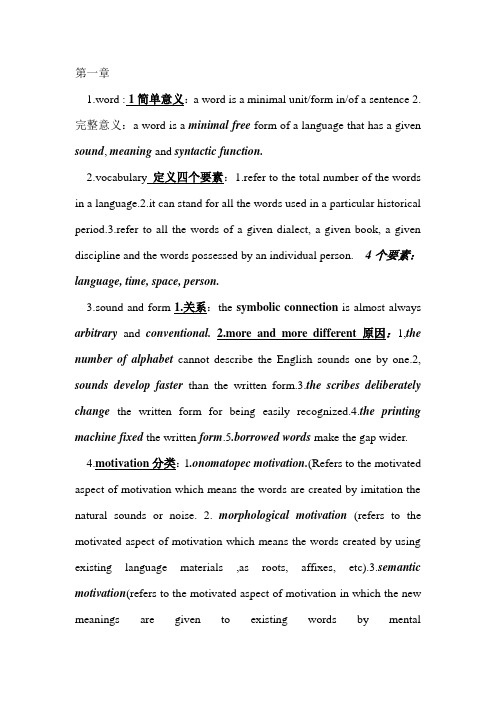
第一章1.word : 1简单意义:a word is a minimal unit/form in/of a sentence2.完整意义:a word is a minimal free form of a language that has a given sound, meaning and syntactic function.2.vocabulary定义四个要素:1.refer to the total number of the words in a language.2.it can stand for all the words used in a particular historical period.3.refer to all the words of a given dialect, a given book, a given discipline and the words possessed by an individual person. 4个要素:language, time, space, person.3.sound and form 1.关系:the symbolic connection is almost always arbitrary and conventional.2.more and more different 原因:1,the number of alphabet cannot describe the English sounds one by one.2, sounds develop faster than the written form.3.the scribes deliberately change the written form for being easily recognized.4.the printing machine fixed the written form.5.borrowed words make the gap wider. 4.motivation分类:1.onomatopec motivation.(Refers to the motivated aspect of motivation which means the words are created by imitation the natural sounds or noise. 2. morphological motivation(refers to the motivated aspect of motivation which means the words created by using existing language materials ,as roots, affixes, etc).3.semantic motivation(refers to the motivated aspect of motivation in which the new meanings are given to existing words by mentalassaiations.4.etymological motivation(refers to the motivated aspect of motivation by which the new meanings can directly tell the origin of the word.)4.word meaning 分类:4. “All national character”is the most important of all the features that may differentiate words of common use from all others.basic word stock基础词汇:1.all national character(全民性,必须有)2.stability 3.productivity 4.polysemy(一词多义)5.collocability(可搭配性) –5.Nonbasic vocabulary. 1。
词汇学复习
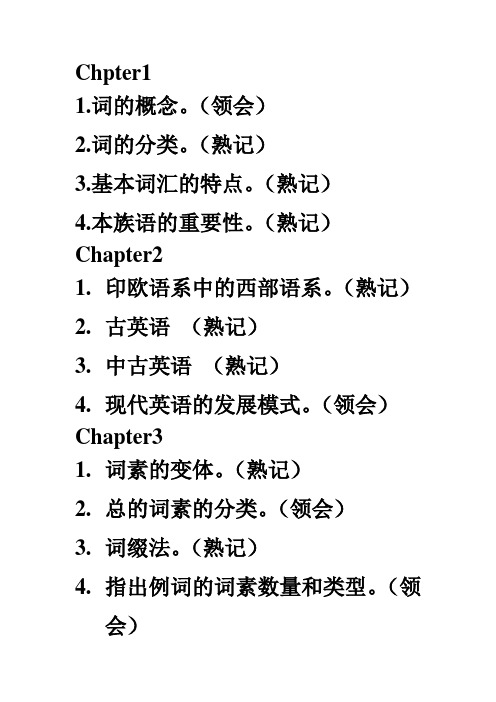
1.词的概念。
(领会)2.词的分类。
(熟记)3.基本词汇的特点。
(熟记)4.本族语的重要性。
(熟记)Chapter21.印欧语系中的西部语系。
(熟记)2.古英语(熟记)3.中古英语(熟记)4.现代英语的发展模式。
(领会)Chapter31.词素的变体。
(熟记)2.总的词素的分类。
(领会)3.词缀法。
(熟记)4.指出例词的词素数量和类型。
(领会)1.前缀的分类。
(熟记)2.转类法的类型。
(领会)3.部分转类法和完全转类法区别.(熟记)4.拼缀法类型。
(领会)5.截断法的概念。
(熟记)6.指出给的例词属于合成词,派生词,转类法的词,拼缀法,截断法,首字母缩略词,首字母拼音词,逆生法,来自于专有名词的词中的哪一个。
Chapter51.所指的概念。
(熟记)2.词的理据。
(熟记)3.理据的分类。
(领会)4.概念意义。
(熟记)5.褒义和贬义。
(领会)Chpter61.同义词的分类。
(熟记)2.反义词的分类。
(领会)3.上下义关系概念。
(熟记)4.语义场的作用。
(熟记)Chapter71.语义的扩大和缩小。
(领会)2.语义的降格。
(熟记)3.语境的作用。
(熟记)Chapter91.习语的特点。
(领会)2.习语的变异形式。
(领会)Chapter101. 单语词典和双语词典。
(熟记)。
2023年自考00832英语词汇学考试重点精华整理

English Lexicology(英语词汇学)1.English lexicology aims at investigating and studying the morphological structures of English words and word equivalents, their semantic structures, relations, historical development, formation and usages.英语词汇学意在调查和研究英语单词和单词旳等价物旳形态构造,其语义构造、关系、历史发展、形成和使用方法。
2.English Lexicology is correlated with such linguistic disciplines as morphology(形态学), semantics(语义学), etymology(词源学),stylistics(文体论)and lexicography(词典学) Chapter 1--Basic concepts of words and vocabulary1.Word(词旳定义): A word is a minimal free form of a language that has a given sound and meaning and syntactic function. (1)a minimal free form of a language (2)a sound unity (3)a unit of meaning (4)a form that can function alone in a sentence词语是语言最小旳自由形式,拥有固定旳声音和意义以及句法作用。
2.Sound and meaning(声音与意义): almost arbitrary, “no logical relationship between the sound which stands for a thing or an idea and the actual thing and idea itself”3.Sound and form(读音和形式):不统一旳四个原因(1)the English alphabet was adopted from the Romans,which does not have a separate letter to represent each other (2)the pronunciation has changed more rapidly than spelling over the years(3)some of the difference were created by the early scribes(4)the borrowings is an important channel of enriching the English vocabulary (5)printing、standardization、dictionary—Old English,The speech of the time was represented very much more faithfully in writing than itis today. 古代英语中旳口语比今天更忠实旳代表书面语—The written form of English is an imperfect representation of the spoken form。
英语词汇学知识点归纳总结

英语词汇学知识点归纳总结
1.词汇分类:英语词汇可以分为实词和虚词两大类。
实词包括名词、
动词、形容词和副词,是能独立存在并具有词义的词类;虚词包括冠词、
介词、连词、代词和助词,是不能独立存在或不具有词义的词类。
2.词根与词缀:英语词汇中有很多词根和词缀,词根是词的核心部分,词缀是附加在词根上的,可以改变词的词义、词性或词形。
3.词义:英语词汇的词义可以通过定义、同义词、反义词、上下义词
等方式进行描述和解释。
词义可以有直观意义、引申意义和隐喻意义等。
4.词汇建构:英语词汇的建构可以通过合成、派生、转化、缩略等方
式进行。
合成是通过将两个或多个词根组合成一个新词,派生是通过添加
前缀或后缀来构成新词,转化是通过改变词的词类来构成新词,缩略是通
过省略部分词组或词根来构成新词。
5.词汇变化:英语词汇的变化形式包括时态、语态、人称、数和比较等。
词汇的变化形式可以通过词形变化、语法变化和语义变化等方式进行。
6.外借词:英语词汇中存在大量的外借词,这些词汇主要来自拉丁语、希腊语、法语、德语等其他语言。
外借词在英语中经过适当的拼写、读音
和意义调整后被接受和使用。
7.同源词:英语词汇中存在一些同源词,这些词源于同一词根或词源,并在语音、形态或词义上有一定的相似性。
了解同源词可以帮助理解和记
忆词汇。
8.词汇扩展:英语词汇在发展的过程中会发生扩展,即一个词从最初的特定意义扩展到更广泛的意义。
词汇扩展可以通过引申、转义、隐喻等方式进行。
这些是英语词汇学中的一些主要知识点,通过对这些知识点的学习和理解,可以更好地掌握和应用英语词汇。
词汇学复习

第一单元英语词汇概说1.词是语音、形态和意义的统一体,音和形是词的物质外壳,意义是词的物质内容。
Word is the combination of pronunciation, morphology and meaning.2.词是在口语和书面语中能独立、自由使用的并具备完整意义的语言最小单位。
Word is the smallest meaningful linguistic unit that can be used on its own in oral and written language.3.词汇(vocabulary, lexicon): collection of words4.词汇是语言(language)的基本要素(语音、语法、词汇)之一。
Pronunciation, grammar, vocabulary5.Active vocabulary(积极性词汇): speaking/writing vocabularyPassive vocabulary(消极性词汇): reading/guessing vocabulary6.词汇学(lexicology): the science of wordsLexicology is the branch of linguistics that investigates, describes and theorizes about vocabulary. 作为语言学的一个分支,词汇学对词汇进行调查研究、描述并予以理论化。
第二、三单元英语基本构词法1.词素(morpheme)是语言中语音和语义的最小结合体。
Morpheme is the minimum unit of meaning.2.构词法(1)词缀法(affixation/derivation派生法)Prefixation 前缀法;Suffixation 后缀法Prefix do not generally change the world-class(词性) of the stem but only modify its meaning.(except “en-”, ”be-”, ”a-”) 三个可以决定词性的前缀Suffix mainly change the word-class ( except “less”)(2)复合法(compounding或composition)→复合词compound(3)转化法(conversion)也叫功能转换法(functional shift)或转移法(transmutation)(4)缩略法(abbreviation或shortening)·截短词clipped wordsapocope截除词尾,aphaeresis 截除词首front and back clipping截除首尾,syncope截除词腰·首字母缩略词initialisms·首字母拼音词acronyms·拼缀词blending e.g. stagflation = stagnation + inflation注:Acronym differ from initialism in that they are pronouncedas words rather than as sequences of letter.(5)逆生法(back formation)e.g. laser为首字母拼音词,因词尾形似后缀-er,则逆生出动词lase。
- 1、下载文档前请自行甄别文档内容的完整性,平台不提供额外的编辑、内容补充、找答案等附加服务。
- 2、"仅部分预览"的文档,不可在线预览部分如存在完整性等问题,可反馈申请退款(可完整预览的文档不适用该条件!)。
- 3、如文档侵犯您的权益,请联系客服反馈,我们会尽快为您处理(人工客服工作时间:9:00-18:30)。
词汇学复习重点1. jargon------ Jargon refers to the specialized vocabularies by which members of particular arts, sciences, trades and professions communicate among themselves such as in business.2. translation loans------ Translation loans are words and expressions formed from the existing material in the English language but modeled on the patterns taken from another language.3. Renaissance------ It is a European movement of learning ancient Greek and Roman classics.4. Allomorph------ one of the variants of the same morpheme5. inflectional affix------ an affix that indicates grammatical relationships6. acronyms------ the process of forming new words by joining the initial letters of names of social and political organizations special noun phrases and technical terms7. back-formation------ the method of creating words by removing the supposed suffixes8. polygsemy------ Polysemy means that one single word has two or more senses at the same time.9. morpheme------ It is a minimal meaningful unit of a language, or it is the smallest functioning unit in the composition of words.10. grammatical meaning------ that part of the meaning of the word indicates grammatical concept or relationships such as part of speech of words, singular and plural meaning of nouns, tense meaning of verbs and their inflectional forms.11. homonym------ Homonyms are words different in meaning but either identical both in sound and spelling or identical only in sound or spelling.12. reference------what a linguistic form refers to in the real word. It is the relationship between language and the world13. semantic field------ Semantic field is concerned with the vocabulary of a language as a system of interrelated lexical networks.14. motivation------ the connection between the linguistic symbol and its meaning.15. conceptual meaning------ the meaning given in the dictionary and forms the core of word-meaning.16. amelioration------ or elevation, a process by which words rise from humble beginnings to positions of importance.17. transfer------ a process whereby words which were used to designate one thing have changed to mean something else.1.Discuss the major characteristics of Basic word stock with examples.Basic word stock contains the following characteristics:All national character: Words of the basic word stock denote the most common things and phenomena of the world around us, which are indispensable to all the people who speak the language.Stability: As they denote the commonest things necessary to life, they are likely to remain unchanged. Stability, however, is only relative.Productivity: Words of the basic word stock are most root words or monosyllabic words; They can form new words with other roots and affixesPolysemy: Words belonging to the basic word stock often possess more than one meaning because most of them have undergone semantic changes in the course of use and become polysemous.Collocability: Many words of the basic word stock have strong collocability.2.What are the major modes of modern vocabulary expansion and give yourexamples.The major modes are creation, semantic change and borrowing.Creation refers to the formation of new words by using existing materials, namely roots, affixes, and other elements. Semantic change means an old form, which takes on a new meaning to meet the new , such as mouse and web. Borrowing has played a vital role in the development of vocabulary, particularly in earlier times. Borrowed words constitute merely six to seven percent of all new words. Creation:词根词缀构成新词semantic change: the word angel is an example. The word is the name of a spiritual being, now, it has a new meaning used to refer to a radar echo caused by something not visually discernible.Borrowing:From French language, English has taken such words as: auteur, black humor, limoFrom German language, English has taken such words as: humoresqueFrom Chinese language, English has taken such words as: Kung fu, wok 3.What are the inflectional affixes frequently used in English? Discuss themeaning each of them indicates.-(e)s— plural number-(e)s—third- person singular present tense-(e)d— past tense -ing— progressive aspect-er— comparative degree-est— superlative degree-'s— possessive case4.How compounds differ from free phrases? Give examples to dwell on this point. phonetic features. In compounds the word stress usually occurs on the first element whereas in noun phrases the second element is generally stressed if there is only one stress. In cases of two stresses, the compound has the primary stress on the first element and the secondary stress, if any, on the second whereas the opposite is true of free phrases, e.g. “a ′green room”is a compound, while “a green ′room”is a free phrase.semantic features. Compounds are different from free phrases in semantic unity. For example, “a green hand”is an “inexperienced person”.Grammatical features.A compound tends to play a single grammatical role in a sentence, for example verb, a noun or an adjective. “Bad-mouth”used as a verb can take the third person singular-s.5.Both back-formation and back-clipping are ways of making words by removingthe endings of words. Explain their differences.Back-formation is the method of creating words by removing the supposed suffixed. It is considered to be the opposite process of suffixation. For example, “loafer” may be assumed to d erive from the verb “loaf” on the analogy of known derivatives, such as “swimmer” from “swim” or “driver” from “drive”. By removing the supposed suffixes -er from “loafer”, a verb “loaf” is coined. Back-clipping is different. The deletion occurs at the end of word. Both the original long word and its short form remain in the same word class.6.What is the relationship between concept and meaning?Meaning and concept are closely connected but not identical. They are both related directly to referents and are notions of the words but belong to different categories. Concept, which is beyond language, is the result of human cognition, reflecting the objective world in the human mind. It is universal to all men alike regardless of culture, race, language and so on whereas meaning belongs to language, so is restricted to language use. A concept can have as many referring expressions as there are languages in the world . Even in the same language, the same concept can be expressed in different words.7.What is the relationship between grammatical meaning and lexical meaning? Grammatical meanings refer to that part of the meaning of the world which indicates grammatical concept or relationships such as part of speech of words, singular and plural meaning of nouns, tense meaning of verbs and their inflectional forms. Grammatical meaning of a word becomes important only when it is used in actual context. Different lexical items, which have different lexical meanings, may have the same grammatical meaning, on the other hand, the same word may have different grammatical meanings. Lexical meaning and grammatical meaning make up the word meaning. It is known that grammatical meaning surfaces only in use .But lexical meaning is constant in all the content words within or without context as it is related to the notion that a word conveys.8.What is the difference between homonyms and polysemants? How todifferentiate them?The difference between homonyms and polysemants lies in the fact that homonyms refer to different words which happen to share the same form and the latter is the one and same word which has several distinguishable meanings. One important criterion is to see their etymology. Homonyms are from different sources whereas a polysemant is from the same source which has acquired different meanings in the course of development. The second principle consideration is semantic relatedness. The various meanings of a polysemant are correlated and connected to one centralmeaning to a greater or lesser degree. On the other hand, meanings of different homonyms have nothing to do with one another. In dictionaries, a polysemant has its meaning all listed under one headwork while homonyms are listed as separate entries.9.Discuss some of the characteristics of antonyms.1) antonyms are classified on the basis of semantic opposition2) a word which has more than one meaning can have more than one antonym3) antonyms differ in semantic inclusion. Pairs of antonyms are seen as marked and unmarked terms respectively.4) contrary terms are gradable antonyms, differing in degree of intensity, so each has its own corresponding opposite.10.What are the causes of semantic changes? Illustrate your point. .There are many causes of semantic change. The main causes include extra-linguistic factors and linguistic factors. In extra-linguistic factors. There are historical reasons, class reasons, and psychological reasons. In linguistic factors, there are shortening of phrases, influx of borrowings and analogy.。
